—————————————————————-
Thank you very much for always reading.
Let’s talk about alcohol.
It’s not a topic I can boast about too much. (^^;)
But somehow, I’ve been collecting photos of “affordable shochu” that I’ve taken before drinking. Now that the collection is complete, I’ve decided to write an article about it.
Some of you may already know everything, but hey.
( ´∀`)人(´∀` )similar!
So here it is!
- The Journey to Affordable Spirits: Iichiko—Not the Destination, But the Starting Point
- Are you still sticking with the ‘ko’-shochu(type A=”Kōrui“)?
- Background Knowledge: What is Honkaku Shochu? The Difference Between Kōrui and Ōtsurui
- 5 Affordable Authentic Shochu (Ōtsurui) Selections
- 1.Hyuga Matsuri (Barley), Miyazaki Prefecture: Produced by Miyakonojo Shuzo
- 2.Kuro Yoshiiichi (Barley), Kagoshima Prefecture: Produced by Wakamatsu Shuzo
- 3.Kome Yoshiiichi (Rice), Kagoshima Prefecture: Produced by Wakamatsu Shuzo
- 4.Kurokamon (Sweet Potato) from Gifu Prefecture: Kikugawa Corporation
- 5.Seven Premium Mugi Shokunin (Barley): Fukutokuchou Liquor
- (Addendum) Apart from the above five selections, there were also these ones:
- Bonus: A Magical Way to Feel a Bit Luxurious Even with Cheap Liquor
- And finally…
The Journey to Affordable Spirits: Iichiko—Not the Destination, But the Starting Point
The saying “All roads lead to Rome” is often attributed to La Fontaine, but for most imbibers, the ultimate destination is shochu, a distinctive Japanese distilled spirit.
During their college years, people typically begin with beer. Some may flaunt their sophistication by ordering a bourbon on a date. Then they venture into the realms of wine, local sake, and occasionally even single malt whiskies. Eventually, they find themselves returning to the dependable and versatile world of shochu. This spirits harmonizes seamlessly with both Western and Japanese cuisine, boasts lower alcohol taxes, and provides a comforting drinking experience.
Initially, at bars, they might opt for shots of various brand-name shochu labels like Sato, Maou or Ikkomon. However, as the time passes, the thought arises: “I’m going to enjoy it anyway,” leading them to purchase entire bottles. As they age, the hassle of going out prompts them to keep 2-3 bottles at home. Gradually, the significance of brand names on those bottles diminishes. Through the Iichiko Silhouette label, they eventually reach the summit: the ‘Downtown Napoleon’ version of Iichiko (a basic grade). It’s a moment of reflection—have they truly come this far? (And when it comes to sweet potato shochu, perhaps it’s akin to the Satsuma Shiranami, right? )
However, there’s more to it.
Yes, it may appear to be the goal, but in reality, this is where it all begins—much like marriage, if you will! (^^)
Beyond the realm of “Iichiko,” lies an expansive field of affordable, no-brand authentic shochu.
Leading the charge in the world of no-brand Honkaku Shochu (authentic shochu called “Ōtsurui” in Japanese) are the private label (PB) brands found in supermarkets. You know them well—the likes of Aeon’s “Top Valu” and Life’s “Kurashi More.” Backed by their overwhelming sales power, these PB brands proudly assert themselves as unbeatable price leaders. Quite grateful, isn’t it?
But wait, there’s more! Beyond that lies a niche category of ultra-budget shochu that leaps like a flying fish (or perhaps that’s a bit dramatic?). At this point, you’ll realize that the so-called “Downtown Napoleon” was actually a premium spirit!
Are you still sticking with the ‘ko’-shochu(type A=”Kōrui“)?
Now, let me explain why I decided to write this article. I have an acquaintance—an older gentleman—who is quite fond of his alcohol. He firmly believes that while quality matters, quantity is even more crucial. As a result, he consistently consumes 4 liters of “Daigorō” or similar budget-friendly “type A” shochu (in PET bottles).
I’ve tried it myself, and unfortunately, it tends to make me feel quite unwell. The next day, I wake up with a pounding headache and severe nausea. Well, it’s true that the comment “You’re drinking too much” is spot-on, isn’t it. (^^;)
Now, here’s the thing: I don’t think it’s very beneficial for the body. After all, they dilute the alcohol, which is continuously distilled and has an alcohol content of around 99%, down to 25% using water. Essentially, it’s akin to disinfectant… Or perhaps that’s just my opinion?
As for that gentleman I mentioned, he persists in drinking it because he considers it cheap (probably enduring the experience). However, you can purchase “type B” shochu (authentic shochu) for nearly the same price or even less. But I suppose, being an elderly person, he finds it tiresome to listen. He’s quite stubborn. Well, if that’s the case, I won’t press the matter.
So, I’d like to share this information with all you open-mind drinkers out there who are willing to lend an ear. Cheers!
Background Knowledge: What is Honkaku Shochu? The Difference Between Kōrui and Ōtsurui
Before we delve into the details, let’s start with some background information. While seasoned drinkers may find this topic as familiar as the back of their hand, there might be others who are less acquainted. If you’re one of those impatient folks yelling, “Enough with the preamble! Just tell me the brand!”—feel free to skip ahead.(^^;)
Now. let’s begin with a comparison table:
| Category | Kōrui(甲類)…Type A | Ōtsurui(乙類)…Type B =Honkaku shochu(Authentic Shochu) |
| Ingredients | Sugarcane, molasses etc. | Wheat, sweet potato, rice, soba, etc. |
| Distillation Method | Continuous distillation | Pot (batch) distillation |
| Characteristics | Pure and clear taste | Retains the flavor of ingredients |
| Typical Ways to Enjoy | Mixed as “chuhai” with something like juice or soda | Enjoying the flavor of the ingredients, such as straight, on the rocks, with water, and with hot water, etc. |
| Popular Brands | Daigoro, Jun, Kyougetsu, Juhyo, etc. | Iichiko, Shiranami, kirishima, Hakutake, etc. |
If you take a look at the brand names, you’ll get the idea. The ones reminiscent of ‘Ethanol~’ fall into the Kōrui category, while those that evoke a ‘Liquor~’ feeling belong to Ōtsurui (authentic shochu).
Now, let’s tackle the confusing part: the distillation process. I’ll keep it straightforward:
-
Ōtsurui (Single Distillation): Imagine a traditional brewery or a small distillery. They load the tank, heat it up, and begin the distillation process. Once it’s complete, the tank is emptied, ready for the next batch. It’s akin to a craft tradition, preserving the flavors of the raw materials.
-
Kōrui (Continuous Distillation): Picture a large industrial plant. Raw materials continuously flow in from the entrance, passing through various stages, and alcohol consistently streams out from the final exit. The result is nearly pure alcohol, devoid of impurities. Sounds pristine, right? Well, personally, I find it somewhat reminiscent of disinfectant, but that’s just my perspective. Brands like “Daigorō” end up at around 25% alcohol, diluted with water before shipping.
Regarding pricing, Kōrui is generally more affordable. Perhaps this is because it’s closer to industrial alcohol. On the other hand, Ōtsurui (honkaku shochu) tends to be pricier overall. The main reasons seem to be differences in raw materials (domestic ones can be costly) and production efficiency. And yes, there are even rare high-end labels like “Mori-Izo” in the Ōtsurui category. Interestingly, I’ve never come across a luxury brand of Kōrui.
That wraps up our rough overview of background knowledge.
Now, let’s dive in!
5 Affordable Authentic Shochu (Ōtsurui) Selections
※Note: Prices are as of the time of writing.
1.Hyuga Matsuri (Barley), Miyazaki Prefecture: Produced by Miyakonojo Shuzo
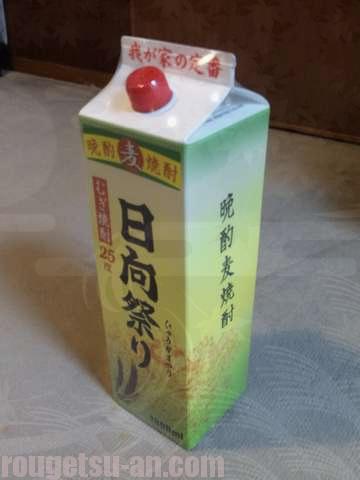
- Price: 950 yen (excluding tax) for 1800ml
Gyomu Super, well-known for imported foods and unbeatable prices, proudly presents this brand as the star player of affordable, authentic shochu in the world. If we were to draw a soccer analogy, it would be akin to having Kagawa Shinji on the Japan national team.
Now, let’s talk about the label design. It doesn’t chase after beauty or coolness at all. Instead, it embraces simplicity and even cheapness. The straightforward label boldly declares it as “Evening Drinking Shochu” and an “Our Household Staple.” No room for imitation here. When you take that first sip, you’ll think, “Ah, I’m enjoying some budget-friendly booze.
And fear not—the taste won’t leave you regretting your choices. It won’t give you a hangover the next morning, unlike Kōrui (type-A) shochu.
By the way, if you happen to possess “Okomeken” (rice vouchers), Gyomu Super accepts them. With these vouchers, you can snag ‘Hyuga Matsuri’ at an even more wallet-friendly budget (perhaps around 10% off?). The same goes for ‘Kurokamon,’ another shochu brand mentioned later.
2.Kuro Yoshiiichi (Barley), Kagoshima Prefecture: Produced by Wakamatsu Shuzo

- Price: 926 yen (excluding tax) for 1800ml
In my local area, this brand is consistently available at the home center “Unidy”. Plus, you receive an additional discount when paying with the Unidicard.
It’s quite delicious. Produced by Wakamatsu Shuzo in Kagoshima. There’s an intriguing theory that its content is the same as their brand “Sassyu Mugi” (barley shochu), but this one is more budget-friendly.
When people think of shochu in Kagoshima, they usually imagine it made from sweet potatoes. However, curiously, despite being from Kagoshima, wheat shochu also exists.
By the way, Unidy allows you to purchase a single bolt (screw), making it incredibly convenient for Sunday mechanics like myself. Here’s to more good times ahead!
Additionally, there are different malt versions. Here, the white koji variety (indicated by ‘Shiro Yoshiichi’ ↓) is priced the same.
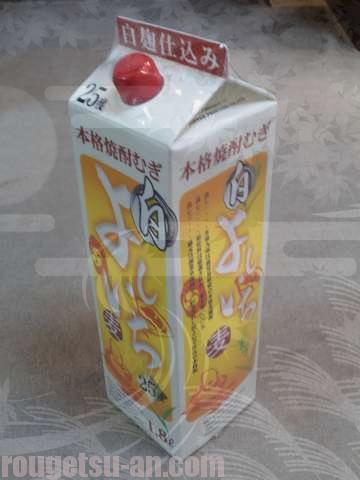
As for taste differences… Well,I’m not entirely sure, haha.
White koji seems to impart a slightly refreshing feeling, but that might just be my imagination (^^;)
Feel free to choose according to your preference.
3.Kome Yoshiiichi (Rice), Kagoshima Prefecture: Produced by Wakamatsu Shuzo
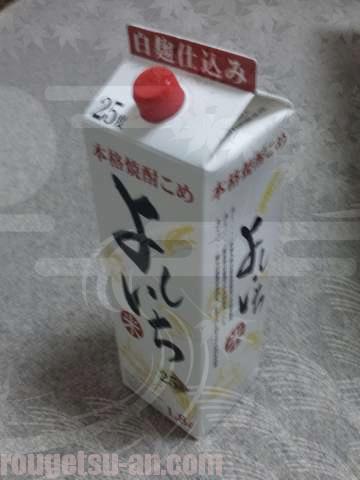
- Price: 1026 yen (excluding tax) for 1800ml
The ‘Yoshiichi’ series includes not only barley but also soba (buckwheat) and rice varieties, all of which are generally priced affordably. This particular one is the rice version.
It appears to be slightly more expensive than the barley variety, by about 100 yen. However, considering that classic rice shochu brands like Hakutake are priced around 1,500 yen, this rice shochu can still be considered a reasonably priced alternative.
If you’re a fan of rice-based spirits, it might be worth your consideration.
4.Kurokamon (Sweet Potato) from Gifu Prefecture: Kikugawa Corporation
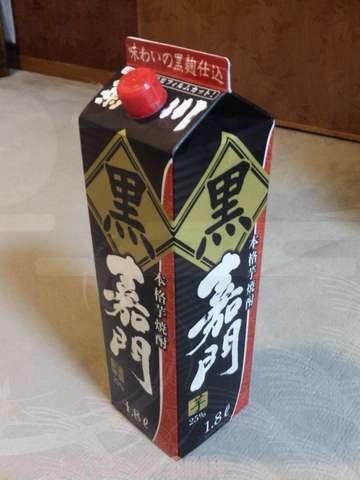
- Price: 925 yen (excluding tax) for 1800ml
As most of you know, the cheapest shochu is usually made from barley. However, when it comes to sweet potato (imo) shochu, the price tends to be about 1.2 times higher for similar brands. But look at this price for sweet potato shochu—unbelievable!
And what’s more, it’s not from Kagoshima, not even from Kyushu; it hails from the mysterious Gifu Prefecture!
Being able to enjoy sweet potato shochu at this price feels like a dream. I won’t claim it’s top-notch, but it definitely has that sweet potato aroma!
As for availability, it’s none other than the reliable cheap supermarket chain, Gyomu Super (Kobe Bussan). Keep up the good work!
Speaking of Gyomu Super, as mentioned earlier, you can use rice coupons there. If you obtain rice coupons from a gift certificate shop in advance, you can purchase items at an even more affordable budget, effectively saving around 10%.
5.Seven Premium Mugi Shokunin (Barley): Fukutokuchou Liquor

- Price: 1028 yen (excluding tax) for 1800ml
This is a private brand from Seven-Eleven (“Seven Premium”), but it’s manufactured by Fukutokuchou Liquor (part of the Oenon Group). According to one theory, the contents are the same as their budget-friendly shochu called “Hakata no Hana.”
Well, PB shochu at this price point is quite common.
However, the remarkable thing about this brand is that you can buy it directly from Seven-Eleven. It’s available for purchase 24/7, and you can even pay with Quo cards.
Compared to other bargain-priced products, it might be slightly on the higher end, but hey, it’s Seven-Eleven! Have you ever been in a situation where you ran out of alcohol late at night? I bet you have. For households like mine, it’s just a three-minute walk to get a refill! (^^;)
Personally, I receive quite a few Quo cards through shareholder benefits. They’re mainly used for purchasing this particular shochu. By the way, if you buy Quo cards in advance from a ticket shop, you can get a substantial discount of around 3% when shopping at convenience stores. Even if it’s not the cheapest option, the convenience of buying it in the middle of the night is quite appealing.
This is off the topic, but… speaking of Seven Premium, they’ve been doing some amazing things lately. Even their red wines are noteworthy. You can find budget-friendly options like Chilean Cabernet starting from around 400 yen. Bordeaux might also be available for around 700 yen. The taste is decent (not bad), and if convenience stores keep offering deals like this, traditional liquor stores might face some tough competition!
Possibly OEM? LAWSON Private Brand “Authentic Shochu ‘Mugi’”
Recently, I also discovered at Lawson (the third-largest convenience store chain).
Perhaps it’s the same as the above Seven Premium ‘Mugi Shokunin.’ The production is also by the same Fukutokuchou Shurui, which means it’s part of the Oenon Group, and the price is the same.
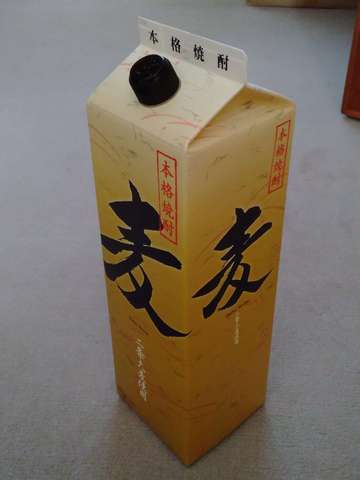
Maybe it has been around for quite some time… I didn’t notice because my nearest convenience store is a Seven-Eleven. For those who have a Lawson nearby, it’s convenient. I imagine it might also be available at FamilyMart !?
Similarly OEM? Family Mart PB “Authentic Shochu ‘Mugi Shochu’”
Found it (laughs).

Here’s just a photo.
(Addendum) Apart from the above five selections, there were also these ones:
Hyuga Matsuri (Sweet Potato), Miyazaki Prefecture: Produced by Miyakonojo Shuzo
This is the sweet potato version of “Hyuga Matsuri.” I happened to find it on sale, so I decided to give it a try. It has a similar design and cohesive color scheme as the barley version, but the base color is purple, giving it a slightly noble vibe.

- Regular Price: ¥1,198 (excluding tax) ⇒ Sale Price: ¥998
At the regular price, it’s still slightly reasonable price, but I didn’t pay attention to it. After all, you can get “Shiranami” (standard brand) for around ¥1,300 at cheaper stores.
This time, due to the sale, I decided to give it a shot. And the verdict is…
Well, it’s definitely iffy.
Actually, I don’t detect much of a sweet potato aroma. The ingredients list includes “sweet potato, rice, and rice koji(=malt)”… Rice? Maybe they skimped a bit on the sweet potato (^^;).
Hmmm, perhaps we’ll stick with the barley version for “Hyuga Matsuri,” shall we?
Mugi no Zen (Barley), Kagoshima Prefecture: Produced by Wakamatsu Shuzo
I stumbled upon something new.
Armed with leftover “Don Quijote“(discount store) gift certificates, I decided to revisit Don Quijote after an extended hiatus (probably more than 5 years). Previously, I held the impression that Don Quijote wasn’t particularly budget-friendly when it came to alcoholic beverages, so it wasn’t on my radar.
And guess what I discovered? There was something like this:

- Price: 938 yen (excluding tax) for 1800ml
The label boldly proclaims “Honkaku Mugi Shochu (Authentic Wheat Shochu)”, yet intriguingly, there doesn’t appear to be a specific brand name. I wonder if it’s their private label product. Instead, the name “Mugi no Zen” discreetly graces a corner of the label.
Given that this product hails from Wakamatsu Shuzo, it might contain similar contents to the previously mentioned “Yoshiiichi (Barley)“. If that’s the case, it’s marginally less affordable than Yoshiichi. For those residing near a Don Quijote store, this could be a delightful discovery!
Furthermore, it seems that some Don Quijote stores accept rice vouchers.
Satsuma no Mai (Sweet Potato), Kagoshima Prefecture: Produced by Wakamatsu Shuzo
Please take a look at the photo below. It’s immediately apparent that this bottle shares nearly the same design as the other Don Quijote shochu series, but this one features sweet potato shochu. I also tried the sweet potato variety.
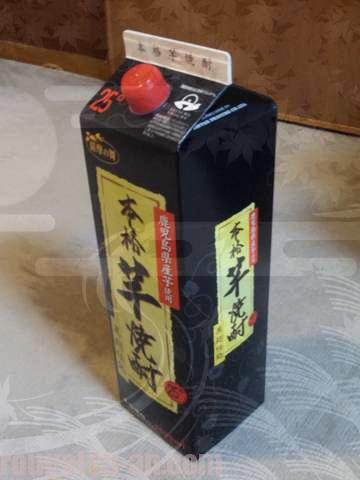
- Price: 1198 yen (excluding tax) for 1800ml
Compared to barley shochu, this one is a bit pricier, costing around 260 yen more (including tax, approximately 300 yen). Similarly, it boldly claims to be ‘Authentic Sweet Potato Shochu,’ but the brand name is likely written in small letters at the upper left corner: “Satsuma no Mai.”
In terms of taste, it’s fairly average—neither outstanding nor disappointing. Unlike the disappointment we experienced with the ‘Hyuga Matsuri‘ sweet potato shochu, you can rest assured with this one. It’s also produced by Wakamatsu Shuzo, so it might be the same as their brand ‘Satsuma Ichi.’ If that’s the case, it’s about 100 yen cheaper than Satsuma Ichi.
While it doesn’t exactly scream ‘bargain’ in terms of price, sweet potato shochu isn’t widely available as a budget brand. It seems that even Kurokamon has seen price increases at many stores. However, in my neighborhood, you can get Kuro Kirishima or Shiranami for around 1,280 yen (excluding tax). Well, it’s difficult to choose, but maybe Shiranami is still the better choice (^^;).
Bonus: A Magical Way to Feel a Bit Luxurious Even with Cheap Liquor
Now, when I say ‘magic,’ it’s nothing other than the good old ‘placebo effect.’
Allow me to introduce the shochu server that everyone knows. This particular one is the ‘inexpensive guy’ that I purchased for 2,000 yen at the Bazaar in Asakusa’s Kappa-Bashi Bridge.
Let’s pour some shochu into it.
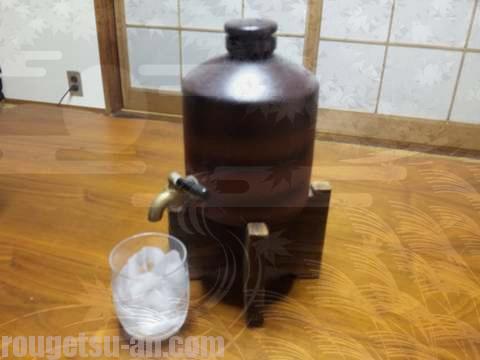
Somehow, I feel like I’m sipping on a fancy drink… Am I the only one?
And finally…
How was it? Even at your local supermarket, there might be a quietly standing gem of an affordable authentic shochu, waiting for you to discover it!
For those living in city apartments where carrying heavy liquor upstairs is a hassle, consider checking out the convenient delivery service ‘Kakuyasu’.
⇒
And please, be mindful not to overindulge! (I’m saying this to others, right?)
Thank you for staying with us until the end today.

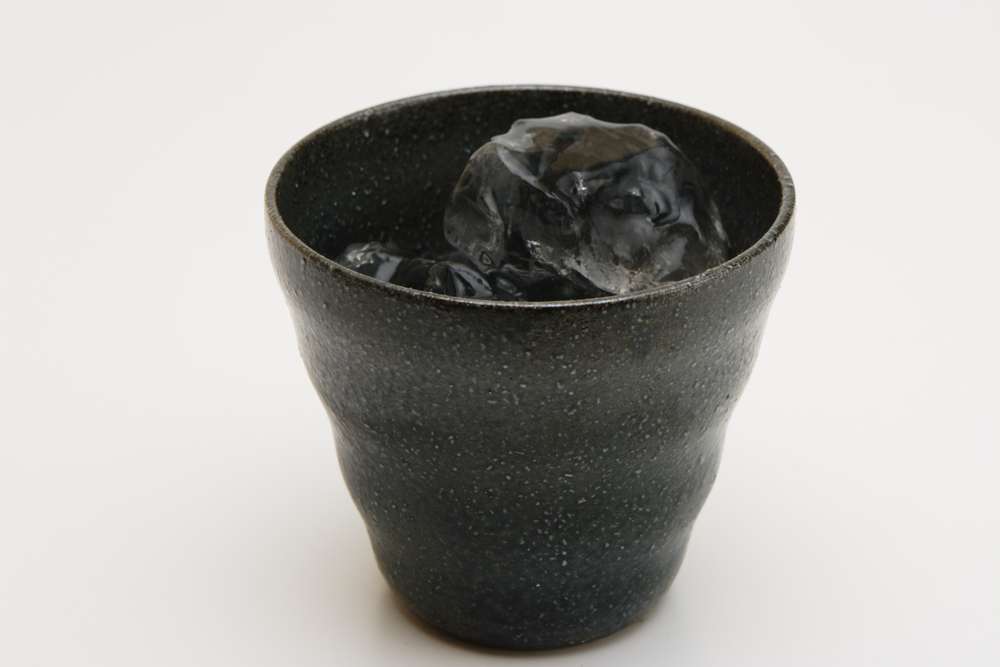









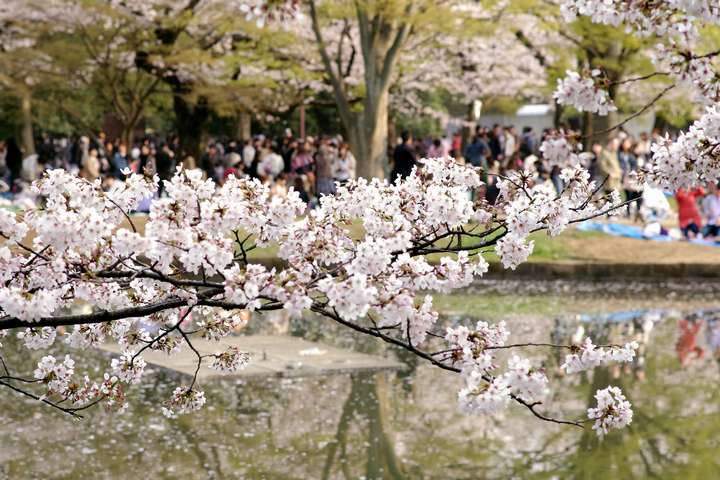
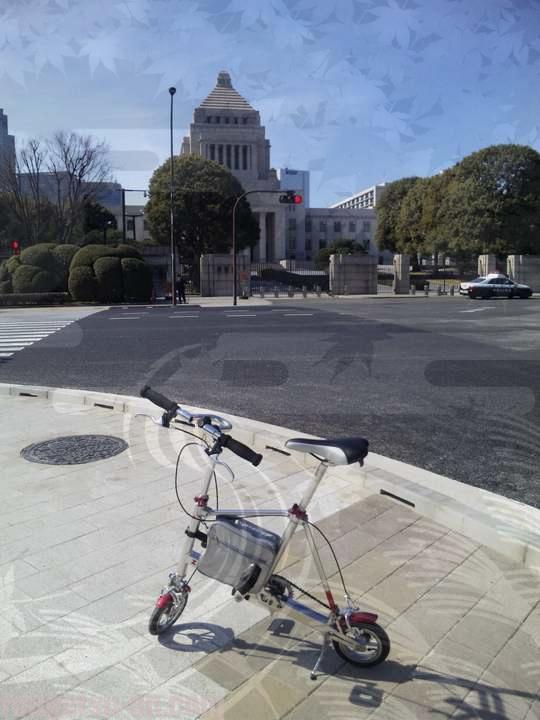
コメント